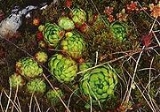
Jovibarba
Encyclopedia
Jovibarba is a small genus
of three species of succulents in the family Crassulaceae
, endemic to mountainous regions in the southeastern quadrant of Europe
. The genus is closely related to Sempervivum. Some taxonomists classify it as a subgenus of Sempervivum. Jovibarba have pale-greenish-yellow or yellow actinomorphic flowers with about six petals, while Sempervivum have generally pinkish flowers with around twice as many petals, which open more widely than Jovibarba flowers. The common name Hen and chicks
is applied to some Jovibarba species (and also species in several other Crassulaceae genera).
Jovibarbas, like Sempervivums, reproduce via offsets
in addition to producing seeds via sexual reproduction. The Jovibarba heuffelii species does not produce offsets on stolons. Instead the offspring of this plant are produced within the mother plant. To propagate it must be split with a knife. The other two Jovibarba species are commonly called rollers. They produce offsets that are lightly attached and easily pop off and roll away from the mother plant. Offsets survive the main rosette
, which is monocarpic.
Species
Only three species are accepted as distinct by the Flora Europaea:
Jovibarba globifera and its subspecies (subsp. hirtum, subsp. allionii, subsp. arenaria) live in the eastern and southern Alps, the Carpathians and the western Balkans south to northern Albania. J. heuffelii occurs in the remainder of the Balkans and the eastern Carpathians, southeast of J. globifera. J. hirta occurs further west, in the southwestern Alps.
Genus
In biology, a genus is a low-level taxonomic rank used in the biological classification of living and fossil organisms, which is an example of definition by genus and differentia...
of three species of succulents in the family Crassulaceae
Crassulaceae
Crassulaceae, or the orpine family, are a family of dicotyledons. They store water in their succulent leaves. They are found worldwide, but mostly occur in the Northern Hemisphere and southern Africa, typically in dry and/or cold areas where water may be scarce...
, endemic to mountainous regions in the southeastern quadrant of Europe
Europe
Europe is, by convention, one of the world's seven continents. Comprising the westernmost peninsula of Eurasia, Europe is generally 'divided' from Asia to its east by the watershed divides of the Ural and Caucasus Mountains, the Ural River, the Caspian and Black Seas, and the waterways connecting...
. The genus is closely related to Sempervivum. Some taxonomists classify it as a subgenus of Sempervivum. Jovibarba have pale-greenish-yellow or yellow actinomorphic flowers with about six petals, while Sempervivum have generally pinkish flowers with around twice as many petals, which open more widely than Jovibarba flowers. The common name Hen and chicks
Hen and chicks
thumb|right|240px| Jovibarba globifera showing larger mother plants and smaller, globe-shaped [[offsets]] .thumb|right|240px| Sempervivum tectorum...
is applied to some Jovibarba species (and also species in several other Crassulaceae genera).
Jovibarbas, like Sempervivums, reproduce via offsets
Offsets
In botany and horticulture Offset is a term used to describe a small virtually complete daughter plant that has been naturally asexually produced on the mother plant. They are clones , meaning that they are genetically identical to the mother plant. In the plant nursery business and gardens they...
in addition to producing seeds via sexual reproduction. The Jovibarba heuffelii species does not produce offsets on stolons. Instead the offspring of this plant are produced within the mother plant. To propagate it must be split with a knife. The other two Jovibarba species are commonly called rollers. They produce offsets that are lightly attached and easily pop off and roll away from the mother plant. Offsets survive the main rosette
Rosette (botany)
In botany, a rosette is a circular arrangement of leaves, with all the leaves at a single height.Though rosettes usually sit near the soil, their structure is an example of a modified stem.-Function:...
, which is monocarpic.
Species
Only three species are accepted as distinct by the Flora Europaea:
- Jovibarba globifera (syn. J. sobolifera; Sempervivum globiferum)
- Jovibarba heuffelii (syn. J. velenovskyi; Sempervivum heuffelii)
- Jovibarba hirta (syn. Sempervivum hirtum)
Jovibarba globifera and its subspecies (subsp. hirtum, subsp. allionii, subsp. arenaria) live in the eastern and southern Alps, the Carpathians and the western Balkans south to northern Albania. J. heuffelii occurs in the remainder of the Balkans and the eastern Carpathians, southeast of J. globifera. J. hirta occurs further west, in the southwestern Alps.
External links
- Flora Europaea search results
- http://plants.usda.gov/java/profile?symbol=JOHE USDA Jovibarba Page
- http://www.drought-smart-plants/jovibarba.html Drought Smart Plants

